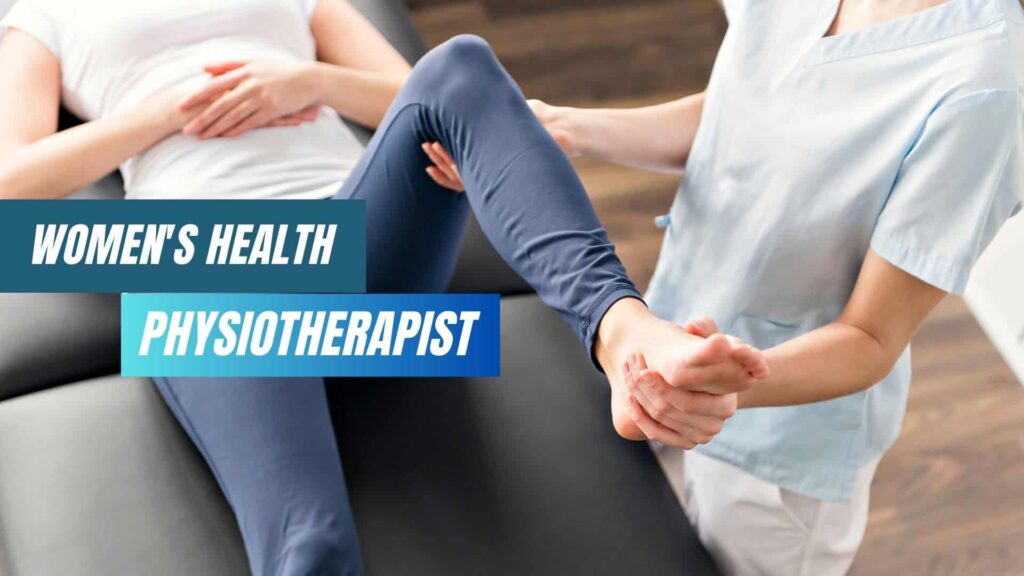Women’s Health Physiotherapy

Women’s health pelvic floor physiotherapy for women’s wellness
Women’s health physiotherapy is a field of physiotherapy that focuses on the specific health needs of women. This includes conditions such as pelvic floor dysfunction, incontinence, Menopause and pregnancy-related musculoskeletal pain. It encompasses general physiotherapy, which focuses on diseases and conditions which are more common in women, but also more specific treatments such as pelvic floor physiotherapy.
Women’s health physiotherapy can help improve the quality of life in women and reduce the impact of these conditions on daily activities.
What is Women’s Health Physiotherapy?
All women have a unique set of physiological characteristics that affect their health and wellness, some of which are due to differences in anatomy, physiology and genetics. Women’s Health physiotherapy is designed specifically for women and addresses the most common health issues experienced by women.

The focus of women’s health physiotherapy in Langley
The focus of women’s health physiotherapy in Langley is to improve the quality of life of women by addressing their unique health needs through a combination of exercise, education, and manual therapy techniques for the following conditions:
The different types of physiotherapy services offered by women’s health physiotherapists at Opal Physio
At Opal Physiotherapy and Health Clinic, our women’s health physio specializes in treating female patients and women with pelvic floor dysfunction. We are committed to providing the best care possible for our patients, which means that not only do we provide treatment but also education and prevention. Our in-depth knowledge of the female anatomy allows us to offer more comprehensive treatment than traditional physiotherapy practices.

Our women’s health physiotherapist at Opal Physio may offer various services depending on the patient’s specific needs. These services may include
- Pregnancy and postpartum physiotherapy
- Pelvic floor dysfunction in Women
- Bladder and bowel dysfunction
- Pelvic pain conditions in women
- Pelvic organ prolapse
- Menopause related symptoms
- Pre and Post gynecological surgery rehabilitation
We can meet each patient’s unique needs and provide them with the care and support they need.
Physiotherapy during pregnancy
Pregnancy can bring on aches and pain in women, and seeing a women’s health physiotherapist can help to relieve pain and discomfort in several ways. First, we can help to improve your posture and alignment, which can take some of the strain off of your back and pelvis. We can also provide exercises to strengthen your core muscles, which can provide support for your back and help to prevent pain and exercises to help improve your flexibility, which can make it easier for you to move around and stay comfortable during pregnancy.
We have experience treating many problems frequently present during pregnancy, including back pain, pelvic discomfort, neck pain, bowel and bladder dysfunction issues, and carpal tunnel syndrome.
If you are experiencing pain or discomfort during pregnancy, be sure to talk to your doctor about whether pelvic health physiotherapy might be right for you. It could be the key to a more comfortable pregnancy!
Postpartum physiotherapy treatment
Following childbirth, pelvic pain and lower back pain are frequent side effects. The abdominal wall and pelvic floor’s tone and control are significantly impacted by the stress and strain of childbirth, regardless of the delivery method. In addition, the new mother is subject to many additional obligations, such as carrying, lifting, and changing the newborn and also can have issues with incontinence from weak pelvic floor muscles.
We at Opal Physio are skilled at handling the problems related to pregnancy, giving birth, and becoming a new mother. We have experience treating many problems frequently present during or after pregnancy, including back pain, pelvic discomfort, neck pain, bowel and bladder dysfunction issues, and carpal tunnel syndrome.
Some of the pre and postpartum conditions that can be helped by a women’s health physiotherapist are:
Call us to book an appointment today at 604-532-7887
Pelvic Floor Dysfunction in women
Pelvic floor dysfunction in women can occur anytime during pregnancy, childbirth, or postpartum and menopause in women. There may be symptoms such as urinary incontinence, fecal incontinence, sexual dysfunction, pelvic organ prolapse and chronic pelvic pain.
The main cause of pelvic floor dysfunctions cannot be fully determined. However, there are several contributing factors that affect women’s health. These include traumatic injuries (to the pelvic area, i. e., accidents), pregnancy, overuse of the pelvic muscles, and poor muscle tone.
For women who experience pelvic floor muscle dysfunction, pelvic physiotherapy is recommended.

Bladder and bowel conditions in women
Pelvic floor physiotherapy is an effective treatment for many common bladder and bowel conditions that affect women. These conditions can include incontinence, pelvic pain, prolapse, and more.
Women’s health physiotherapists trained in pelvic floor physiotherapy can help to improve a woman’s quality of life by reducing or eliminating symptoms, improving function, and increasing strength and control.
Our physiotherapist will assess the individual woman’s needs and create a tailored treatment plan. Some common treatments used in managing pelvic floor conditions include exercises, education, biofeedback and manual therapies. These treatments can help to improve muscle function and control, reduce pain, and increase the overall quality of life.
Some of the common conditions include the following:
Stress Incontinence
Stress incontinence is an involuntary loss of urine. It is not a condition that affects all women, but it does affect many. Stress incontinence occurs with pelvic floor muscle weakness. This can cause the bladder to leak urine during physical activity or when coughing, sneezing or laughing.
Urge Urinary Incontinence
Urge incontinence is a type of urinary incontinence that happens when a person feels the urge to urinate and immediately loses control, resulting in the bladder releasing urine. The need to urinate may be sudden and urgent, or it may be gradual.
Urinary Urgency and Frequency
Urinary urgency is the sensation of needing to urinate immediately, and frequency is the need to urinate more often than usual. This can sometimes be associated with pain.
Overactive Bladder
An overactive bladder is a bladder that contracts too often, resulting in the urge to urinate more frequently than is necessary. This condition can be caused by a variety of factors, including trauma, infection, medications, pregnancy, and menopause.
Learn about Overactive Bladder Treatment.
Constipation
Constipation is the passage of hard, dry stool that is difficult to pass. It can be because of a bowel obstruction, reduced intestinal motility, or a low-fibre diet. Constipation may also be caused by many other factors, such as certain medications or health conditions. Symptoms include abdominal cramps, bloating, gas and a feeling of incomplete evacuation.
Learn about Constipation Treatment.
Pelvic Pain Conditions
There are many different pelvic pain conditions that can affect women’s health. Some of the more common women’s health conditions include endometriosis, uterine fibroids, and ovarian cysts. Pelvic pain can also be caused by pelvic inflammatory disease and pregnancy.
For many women, pelvic pain is a chronic condition that can cause a great deal of discomfort and pain. Often, pelvic pain is worse during certain times of the month, such as during menstruation or ovulation. Pelvic pain can also be aggravated by sexual activity, urination, or defecation.
Learn about Pelvic Pain Treatment.
Vaginismus
Vaginismus is when the pelvic floor muscles tightens or spasms, that can make sexual intercourse difficult or quite painful. It can be caused by psychological factors, such as anxiety or trauma, or physical factors, such as inflammation or injury. Treatment may involve pelvic floor exercises and the use of vaginal dilators.
Learn about Vaginismus Treatment.
Dyspareunia
Dyspareunia is a common condition that usually affects women, causing vaginal pain during intercourse, It can be caused by medical conditions, injury or even certain gynecological procedures. Physical therapy is often used to help individuals with dyspareunia due to pelvic floor muscle tension, pelvic organ prolapse, chronic constipation and more.
Learn about Dyspareunia Treatment.
Vulvodynia / Vestibulodynia
Vulvodynia is chronic pain in the vagina that has no known cause. Vestibulodynia is a pain in the vagina that is caused by inflammation of the vestibule, the area around the vaginal opening. Both conditions can be very painful and make intercourse and other activities involving the vagina, such as urinating or inserting a tampon, very uncomfortable.
Learn about Vestibulodynia Treatment.
Bladder Pain Syndrome / Interstitial Cystitis
Bladder Pain Syndrome is characterized by intense pain that is felt in the bladder region. This pain can be increased with urination and can linger even after emptying the bladder. The best way to combat this chronic condition is with a physiotherapy treatment plan that includes manual therapy and pelvic floor therapy.
Learn about Interstitial Cystitis Treatment.
Pudendal Neuralgia
Pudendal Neuralgia is a painful condition that affects the nerves in the pelvic region. It can cause pain or numbness in the genitals, rectum and perineum. The most common cause is constant pressure on these nerves caused by sitting for long periods of time without good posture. Women’s health pelvic Physio can help people with Pudendal Neuralgia to learn how to sit correctly and stretch manually.
Endometriosis
Endometriosis is a common women’s health condition in which the lining inside of the endometrium layer in uterus grows further past the uterus. Endometriosis is often a painful condition and can cause heavy and irregular periods. Hands-on pelvic floor treatment can help manage and reduce pain and tightness symptoms that people with endometriosis experience.
Learn about Endometriosis Treatment.
Dysmenorrhea
Dysmenorrhea is a medical term to describe painful or uncomfortable menstrual periods. Cramping is a very common symptom of dysmenorrhea, which often feels like bad period pain or stomach ache. The pain can be so severe that it interferes with daily activities, relationships and school or work. It can last anywhere from 2-3 days to an entire week. PT can help manage this condition in various ways, such as myofascial work, pelvic floor exercise prescription and relaxation techniques to help reduce stress and uterine contractions.
Learn about Dysmenorrhea Treatment.
Proctalgia Fugax
Proctalgia fugax is a condition that is characterized by brief, intense pain in the lower rectum and anal area or on the perineum. The pain can be triggered by several factors, such as coughing, sexual activity, or sitting for too long. Pelvic PT for women can help with pain through a variety of treatments, such as pelvic floor muscle training, biofeedback, and muscle stimulation therapy to help relax the muscles.
Coccydynia – Tailbone pain
Coccydynia is a pain in the coccyx or tailbone. This pain can be caused by an injury to the coccyx, prolonged sitting on hard surfaces, infection or arthritis. A physical therapy evaluation will help determine if biomechanical factors such as tightness in the glutes, hip flexors, and hamstrings may contribute to the discomfort. The therapist may recommend targeted exercises.

Pre and Post-Operative Gynecological Surgery Rehabilitation
Gynecological surgery can be a very daunting and stressful experience for any woman, which is why it is so important to have a good support system in place both before and after the procedure. This is where women’s health physiotherapy comes in, as it can help with healing and get you back on your feet as soon as possible.
Recovery from gynecological surgeries can be challenging. The pelvic floor muscles are often weakened during gynecological surgery, which can lead to Urinary incontinence, Sexual dysfunction, and Pelvic organ prolapse.
Pre-operative physiotherapy can help to improve your range of motion, flexibility and help prepare the muscle for surgery which can make the surgery itself less traumatic. It can also help to reduce any anxiety or stress you may be feeling about the procedure.
Post-operative physiotherapy is essential in helping you to recover from the surgery as quickly and safely as possible. It can help to improve your circulation, reduce swelling and pain, and restore your range of motion. It is important to start physiotherapy as soon as possible after your surgery to get the best possible results.
The goal of physiotherapy treatment after any gynecological surgery is to help you regain strength and balance in your pelvic floor muscles as well as other muscle groups that support your pelvis. Physiotherapy can also help you learn how to perform appropriate Kegel exercises to help prevent urinary incontinence after surgery, improve sexual function and reduce the risk of developing pelvic organ prolapse.
Pelvic Organ Prolapse
Pelvic organ prolapse is one of the most common conditions treated by women’s health physiotherapists trained in pelvic floor physiotherapy. Pelvic organ prolapse happens when the tissues and muscles that support the pelvic organs (uterus, bladder, and rectum) become weak or damaged and cannot hold the organs in position. This can cause the organs to bulge or sag into the vaginal canal.
Pelvic organ prolapse is often caused by pregnancy, childbirth, or menopause. Treatment for pelvic organ prolapse typically includes pelvic floor exercises and other forms of physical therapy to help retrain the weak muscles.
Menopause
Menopause is a biological system that denotes the completion of a woman’s reproductive function. While menopause itself is not a health condition, the changes it brings about in a woman’s body can lead to a number of health problems. Women’s health physiotherapy can effectively help and manage many health conditions associated with menopause, such as osteoporosis, hot flashes, sleep problems, vaginal dryness, and urinary incontinence.
Physiotherapy can also help reduce the risk of osteoporosis, a common concern for women during and after menopause. If you are experiencing any menopause-related health problems, talk to your doctor about whether physiotherapy could be right for you.
Physiotherapy can help to improve circulation, reduce stress, and increase energy levels. It can also help to improve sleep and reduce hot flashes. These issues occur due to hormone level imbalance, and performing cardiovascular exercises can help.
Helps to improve strength and balance: Exercises can help to strengthen muscles and improve balance and flexibility to help reduce the risk of falls and any fractures.
One of the common issues that affect many women in menopause is pain during intercourse. Pelvic physiotherapy can help improve muscles and tissues that need to be addressed.
Women also experience incontinence with menopause and can also have overactive bladder, which usually occurs due to the weakening of pelvic floor muscles. Pelvic floor exercises can help in improving incontinence issues.
At Our Langley women’s health physiotherapy centre, our Physiotherapists are trained in the anatomy of the Women’s pelvic floor and musculoskeletal system and can aid in assessing and treating pelvic floor problems. Monitoring and providing individualized Women’s pelvic floor physiotherapy and exercise help to effectively treat and prevent disorders of the pelvic floor in Women.
